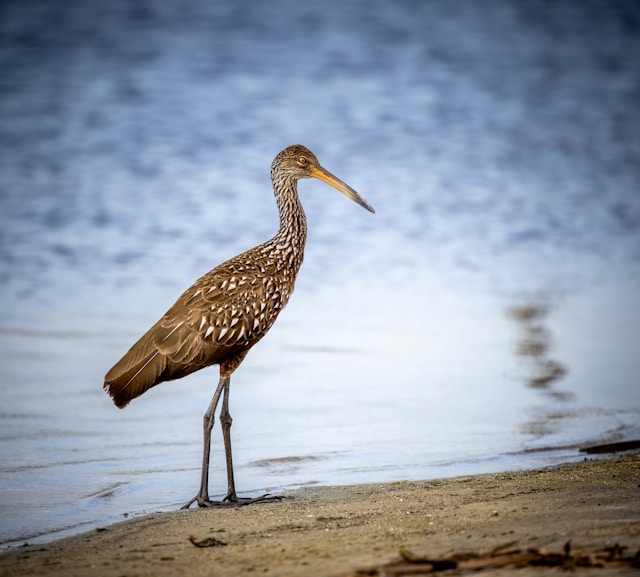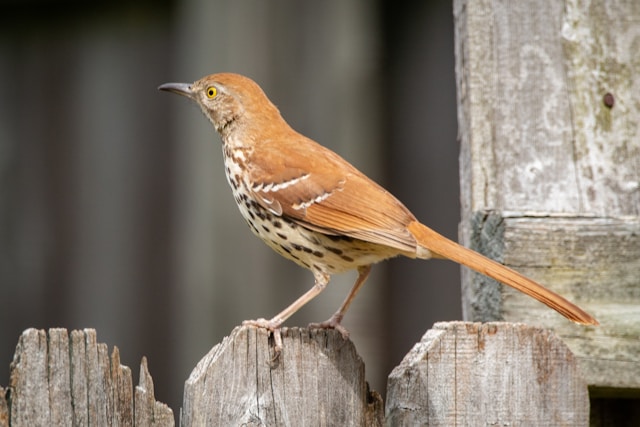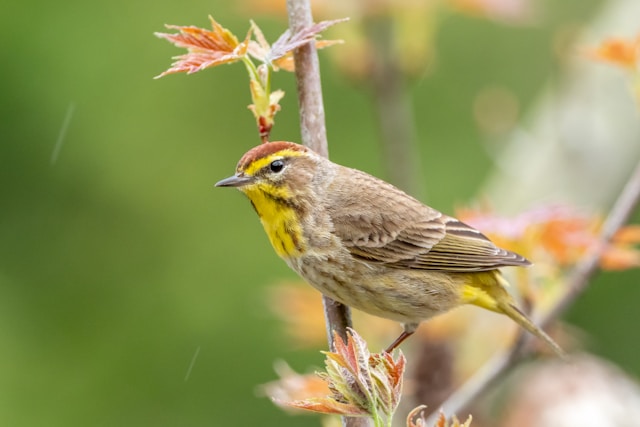Florida’s diverse habitats—spanning wetlands, forests, grasslands, and coastal regions—make it a haven for birdwatchers. Among the vibrant feathered residents and visitors are an impressive variety of brown birds, often overlooked for their more colorful counterparts. These birds, however, hold their own charm with intricate plumage patterns, unique behaviors, and significant ecological roles.
From small sparrows flitting through thickets to majestic brown raptors soaring above, Florida offers an array of brown birds that captivate nature enthusiasts. Whether you’re a seasoned birder or a curious observer, this guide will introduce you to 15 fascinating types of brown birds you can encounter across the Sunshine State.
Each bird tells its own story of adaptation and survival in Florida’s rich ecosystems, offering a deeper appreciation of the subtleties of nature. So grab your binoculars and prepare to meet these understated avian wonders.
Types of Brown Birds in Florida
1. Northern Mockingbird

The Northern Mockingbird (Mimus polyglottos) is a versatile and highly adaptive songbird found throughout North America, particularly in the southern and central regions of the United States.
Known for its remarkable ability to mimic a wide variety of sounds, including other birds, animals, and even mechanical noises, the Northern Mockingbird is a master of vocal mimicry.

2. Mourning Dove

The Mourning Dove (Zenaida macroura) is a gentle and graceful bird commonly found across North America. Recognizable by its slender, grayish-brown body, small head, and long, tapered tail with white edges, the Mourning Dove measures about 9 to 13 inches in length with a wingspan of 17 to 18 inches. Its soft, mournful cooing sound, reminiscent of a melancholy flute, gives the species its name.
Mourning Doves inhabit open woodlands, suburban areas, and agricultural fields, often foraging on the ground for seeds, which make up the majority of their diet.
They are also frequent visitors to backyard feeders. These birds are known for their swift, straight flight, characterized by rapid wingbeats and a distinctive whistling sound created by their wings.
Highly adaptable, Mourning Doves mate for life and build flimsy nests in trees, shrubs, or even on building ledges. They symbolize peace and are cherished for their calm presence.
3. Brown Pelican

The Brown Pelican (Pelecanus occidentalis) is a distinctive and iconic seabird, often recognized as one of the large brown birds in Florida and other coastal areas of North, Central, and South America. Recognized by its large size, long bill with a spacious throat pouch, and striking plumage, adult Brown Pelicans have a grayish-brown body, white neck, and yellow head, with black flight feathers.
They measure about 4 feet in length, boast a wingspan of 6 to 7 feet, and weigh 6 to 12 pounds.
Unlike other pelicans, the Brown Pelican is known for its dramatic feeding technique: it dives from considerable heights into the water to catch fish, its primary food source. Its expandable throat pouch aids in scooping up prey and draining water before swallowing.
These social birds are often seen resting in flocks on beaches, docks, or mangroves. Once endangered due to pesticide pollution, conservation efforts have successfully restored their populations, making them a symbol of environmental recovery.
4. Carolina Wren

The Carolina Wren (Thryothorus ludovicianus) is a small yet spirited songbird commonly found in the eastern United States. It is characterized by its warm reddish-brown upperparts, buff-colored underparts, and a distinct white stripe above its eye.
Measuring about 5 to 5.5 inches long with a wingspan of 7 to 8 inches, it is a compact and active bird with a slightly curved bill.
This wren is best known for its loud and clear song, often rendered as “tea-kettle, tea-kettle, tea-kettle,” which males sing year-round to establish territory and attract mates.
Carolina Wrens are highly adaptable and can thrive in a variety of habitats, including forests, swamps, gardens, and suburban areas.
They are cavity nesters, building dome-shaped nests in natural crevices or unconventional spots like mailboxes and flowerpots.
Their diet consists primarily of insects, spiders, and small fruits, and their curious nature and cheerful presence make them a favorite among bird enthusiasts.
5. Boat-tailed Grackle

The Boat-tailed Grackle (Quiscalus major) is a striking and vocal bird found along coastal areas of the southeastern United States and parts of the Gulf Coast.
This large blackbird measures about 10 to 15 inches in length, with males being significantly larger than females.
Males have glossy, iridescent plumage that shines purple, green, or blue in sunlight, while females are smaller and sport a rich brown coloration.
One of the most distinctive features of the Boat-tailed Grackle is its long, keel-shaped tail, which fans out in flight and adds to its graceful appearance.
These birds are often found in marshes, estuaries, and urban environments near water. They are highly social, forming large flocks that can be quite noisy with their array of sharp calls, whistles, and squawks.
Their diet is omnivorous, including insects, small aquatic creatures, grains, and human scraps. Bold and adaptable, they are a common sight in coastal habitats and urban areas alike.
6. Eastern Phoebe

The Eastern Phoebe (Sayornis phoebe) is a charming and adaptable brown bird with a yellow belly, often seen in Florida,, especially during the winter months. This small flycatcher is about 5.5 to 6.7 inches long, with a wingspan of 10 to 11 inches.
Its plumage is a soft grayish-brown above, fading to a pale whitish-yellow on the underparts, and it has a slight crest that it frequently flattens or raises.
Eastern Phoebes are known for their habit of wagging their tails up and down while perched. They are primarily insectivorous, catching their prey in mid-air with acrobatic skill, though they also eat small fruits and berries during colder seasons.
Commonly found in open woodlands, gardens, and near water sources, the Eastern Phoebe often nests on human-made structures like bridges and eaves. Its call, a clear “fee-bee,” is a familiar sound in its range. Their adaptability and calm demeanor make them a favorite among bird watchers in Florida.
7. Limpkin

The Limpkin (Aramus guarauna) is a distinctive wading bird commonly found in Florida’s wetlands, known for its unique appearance and haunting calls.
Measuring about 25 to 29 inches in length with a wingspan of 40 to 42 inches, it has a slender body, long legs, and a slightly curved bill.
Its brown plumage is mottled with white streaks, providing excellent camouflage in marshy habitats.
Limpkins thrive in freshwater environments such as swamps, marshes, and along the edges of rivers and lakes, where they are often spotted walking slowly in search of food.
Their diet primarily consists of apple snails, which they skillfully extract from their shells using their specialized bill, along with other small aquatic creatures.
This bird’s eerie, wailing call is a signature sound of Florida’s wetlands, especially at night. As an emblem of the state’s rich biodiversity, the Limpkin is a favorite among bird watchers and nature enthusiasts.
8. Brown Thrasher

The Brown Thrasher (Toxostoma rufum) is a striking and melodious bird commonly found in Florida, known for its vibrant songs and secretive nature.
Measuring about 9 to 12 inches in length with a wingspan of approximately 13 inches, this bird has a slender body, long tail, and slightly curved bill.
Its reddish-brown plumage on the upperparts contrasts beautifully with its pale underparts streaked with dark brown markings.
Brown Thrashers are skilled vocalists, capable of mimicking other bird calls and producing a repertoire of over 1,000 song variations. They are most often heard during spring, singing from dense shrubs or tree branches to establish their territory.
These birds thrive in thickets, forest edges, and residential areas with plenty of cover.
Their diet includes insects, fruits, and seeds, which they forage by vigorously flipping leaves on the ground. Elusive yet enchanting, the Brown Thrasher adds beauty and melody to Florida’s natural landscapes.
9. Palm Warbler

The Palm Warbler (Setophaga palmarum) is a small and charming songbird commonly found in Florida during its winter migration. Measuring about 5 to 5.5 inches in length with a wingspan of 7.5 to 8 inches, this bird is easily recognized by its warm brown upperparts, yellowish underparts, and distinctive chestnut cap. One of its signature traits is its habit of constantly bobbing its tail as it forages.
Palm Warblers are versatile and thrive in a variety of habitats, including open fields, marshes, and coastal scrublands. They are ground foragers, often seen hopping along the ground or low vegetation, searching for insects, spiders, and seeds.
This warbler is a lively presence in Florida’s landscapes, often traveling in mixed flocks with other small birds. Its soft, musical chirps and active behavior make it a delightful sight for birdwatchers and nature enthusiasts exploring the Sunshine State.
10. Sedge Wren

The Sedge Wren (Cistothorus stellaris) is a small, elusive bird that adds charm to Florida’s marshy landscapes.
Measuring about 4.5 to 5 inches in length with a wingspan of 5.5 to 6 inches, this wren has a compact body, a short tail, and a slender bill. Its plumage is a mix of brown and buff with intricate streaking on its back, helping it blend seamlessly into grassy habitats.
Found in marshes, wet meadows, and grassy fields, the Sedge Wren is a shy bird that prefers dense vegetation, where it forages for insects and spiders. Its quick, jerky movements and low-profile behavior make it a challenge to spot, but its distinctive song—a series of rapid, chattering notes—often gives away its presence.
Sedge Wrens are seasonal residents in Florida, primarily during the winter months. Their preference for undisturbed wetland habitats underscores the importance of conservation efforts to preserve these ecosystems.
11. Eastern Towhee

The Eastern Towhee (Pipilo erythrophthalmus) is a striking and melodic bird often found in Florida’s woodlands and brushy habitats. Measuring about 6.8 to 8.2 inches in length with a wingspan of 7.9 to 11 inches, this species is a notable example of common brown birds in Florida. Males have a rich black upper body, while females display warm brown tones, both complemented by a white belly and reddish-orange sides.
Eastern Towhees are ground foragers, using their feet to scratch through leaf litter in search of seeds, insects, and berries. Their distinctive “drink-your-tea” song is a common sound in Florida’s forests, especially during the breeding season.
These birds prefer thickets, forest edges, and overgrown fields, where they can remain hidden while foraging or nesting. Their vibrant appearance, paired with their rich, musical calls, makes the Eastern Towhee a favorite among birdwatchers in Florida.
12. Great Horned Owl

The Great Horned Owl (Bubo virginianus) is one of Florida’s most iconic brown birds, known for its striking appearance and haunting hoots. Measuring 18 to 25 inches in length with a wingspan of 3.5 to 4.8 feet, this large owl is instantly recognizable by its mottled brown plumage, piercing yellow eyes, and prominent ear tufts, which resemble “horns.”
These nocturnal predators are highly adaptable, thriving in a wide range of habitats, including forests, wetlands, and even urban areas. Their plumage provides excellent camouflage, allowing them to blend seamlessly into tree bark during the day. At night, they are powerful hunters, preying on mammals, birds, reptiles, and insects.
The Great Horned Owl’s deep, resonant hoots are a signature sound of Florida’s nights, especially during the breeding season.
Known as fierce protectors of their nests, these owls are symbols of wisdom and strength, captivating birdwatchers and nature enthusiasts alike.
13. Hermit Thrush

The Hermit Thrush (Catharus guttatus) is a modest yet enchanting brown bird often seen in Florida during the winter months.
Measuring about 6 to 7 inches in length with a wingspan of 9 to 11 inches, this small thrush is known for its warm brown back, reddish tail, and pale underparts with distinct dark spots on its chest. Its quiet demeanor often belies its extraordinary singing abilities.
This bird thrives in woodlands, forests, and shrubby areas, where it forages on the ground for insects, spiders, and berries.
The Hermit Thrush is recognized for its ethereal, flute-like song, characterized by clear, ascending notes and complex harmonies, often delivered at dusk or dawn.
Unlike many migratory thrushes, the Hermit Thrush prefers to overwinter in Florida’s milder climate. Its combination of understated beauty and exquisite vocalizations makes it a favorite among birdwatchers exploring the state’s natural habitats.
14. Rose-breasted Grosbeak

The Rose-breasted Grosbeak (Pheucticus ludovicianus) is a captivating songbird occasionally seen in Florida during migration. While males are celebrated for their black and white plumage with a vivid rose-colored chest patch, females and juveniles are more subdued, displaying warm brown plumage with streaked underparts and a white eyebrow stripe.
Measuring about 7 to 8 inches in length with a wingspan of 11 to 13 inches, this bird is known for its sturdy, seed-cracking bill. Rose-breasted Grosbeaks prefer wooded areas, forest edges, and gardens, where they forage for seeds, fruits, and insects.
Their sweet, melodic song is often compared to that of a robin, but richer and more complex. In Florida, these birds are primarily observed during spring and fall migrations.
Their presence adds a splash of beauty and melody to the state’s landscapes, delighting birdwatchers fortunate enough to spot them during their journeys.
15. Louisiana Waterthrush

Have you ever spotted a bird confidently strutting along a stream, tail bobbing with flair? Say hello to the Louisiana Waterthrush!
This delightful brown bird is a winter visitor in Florida, adding charm to the state’s wetlands and wooded streams. Unlike many warblers that stick to the treetops, this one prefers a life on the ground, foraging along the water’s edge for insects, spiders, and other tasty morsels.
With its warm brown plumage, creamy streaked underparts, and bold white eyebrow, the Louisiana Waterthrush stands out despite its subtle tones. But what really makes this bird special is its song—a melodious cascade of notes that mimics flowing water, bringing a touch of nature’s music to its surroundings.
As one of the earliest migrating warblers, the Louisiana Waterthrush is a herald of spring for bird enthusiasts in Florida. Spotting one feels like uncovering a hidden gem in the wild!
Conclusion:
Florida’s diverse ecosystems provide a haven for a wide variety of brown birds, each playing a unique role in the state’s rich natural tapestry. From the haunting hoots of the Great Horned Owl to the melodic songs of the Hermit Thrush and the vibrant presence of the Rose-breasted Grosbeak, these birds captivate with their beauty and behaviors. The Limpkin’s wetlands wanderings and the Louisiana Waterthrush’s streamside foraging highlight the importance of Florida’s water-rich habitats, while species like the Eastern Towhee and Brown Thrasher thrive in wooded and brushy areas.
These brown birds not only add visual charm but also contribute to the ecological balance by controlling insect populations, dispersing seeds, and pollinating plants. Observing and protecting these birds reminds us of the vital role conservation plays in preserving Florida’s biodiversity. Whether you’re a seasoned birdwatcher or a casual observer, Florida’s brown birds offer endless opportunities for discovery and connection with nature

Welcome to World Birds Life, where the wonder of birds takes center stage. My name is Lexi, and I’m passionate about helping you discover the beauty and joy that birds bring into our lives.







